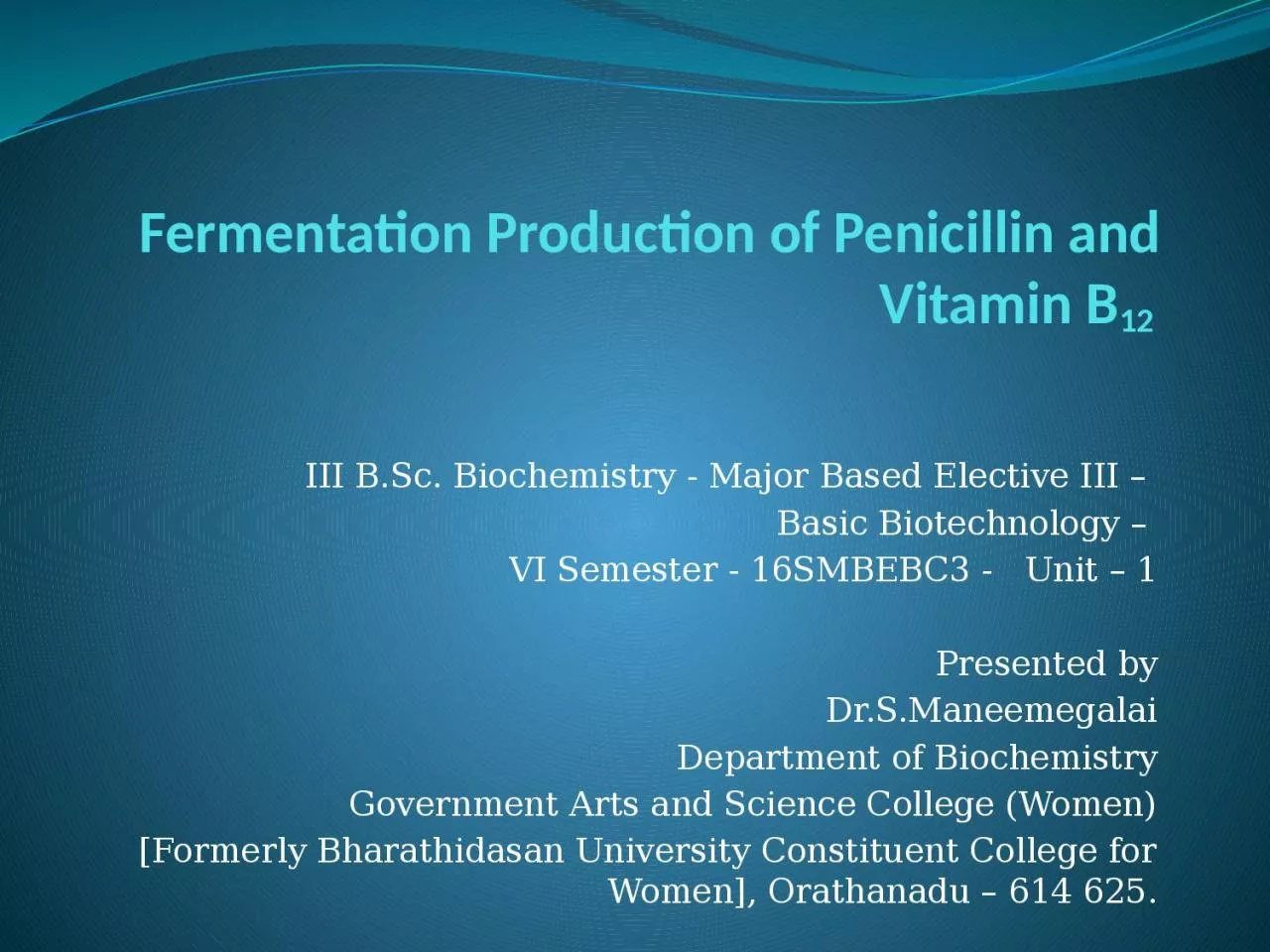

12 III BSc Biochemistry Major Based Elective III Basic Biotechnology VI Semester 16SMBEBC3 Unit 1 Presented by DrSManeemegalai Department of Biochemistry Government Arts and Science College Women ID: 1044074
Download Presentation The PPT/PDF document "Fermentation Production of Penicillin an..." is the property of its rightful owner. Permission is granted to download and print the materials on this web site for personal, non-commercial use only, and to display it on your personal computer provided you do not modify the materials and that you retain all copyright notices contained in the materials. By downloading content from our website, you accept the terms of this agreement.
1. Fermentation Production of Penicillin and Vitamin B12 III B.Sc. Biochemistry - Major Based Elective III – Basic Biotechnology – VI Semester - 16SMBEBC3 - Unit – 1 Presented byDr.S.ManeemegalaiDepartment of BiochemistryGovernment Arts and Science College (Women)[Formerly Bharathidasan University Constituent College for Women], Orathanadu – 614 625.
2. PenicillinIt is an antibiotic.Produced from high yielding strains of Penicillium chrysogenum.The high yielding strains are unstable.They are maintained as spore suspension in sterile inert support or lyophilised in appropriate media or stored under liquid nitrogen.
3. Structure of Penicillin
4.
5. Requirements for productionInoculumRaw materials for MediumProductionExtraction and Purification
6. InoculumComposition of inoculum (sporulation) mediumGlycerol – 7.5 g/lCane molasses – 7.5 g/lCorn steep liquor – 2.5 g/lMagnesium sulphate – 0.050 g/lPotassium dihydrogen phosphate – 0.060 g/lPeptone – 5 g/lSodium chloride – 4 g/lFe – tartrate – 0.005 g/lCopper sulphate – 0.004 g/lAgar – 2.5 g/lDistilled water – 1 litreTemperature – 24°CSterilized and adequate sterilized air must be supplied
7. Inoculation MethodSodium lauryl sulphonate is used prepare a uniform of suspension of spores of high yielding Penicillium strains.After adding the suspension to production medium, the medium is agitated and aerated.
8. Production mediumThe raw materials in production medium must favour abundant growth of myceliumProduce maximum penicillinEasy to extract and purify penicillin.Raw materials:Carbon source: 6% lactose or glucose and sucroseNitrogen source: Ammonium salts, ammonia gas or corn steep liquorMineral source: Potassium, phosphorous, magnesium, sulphur, zinc and copper.Corn steep liquor provides some minerals. They are supplied as sulphates and phospates.
9. Precursors for penicillin production:The required penicillin is produced by the addition of phenyl acetic acid derivatives.Eg., Penicillin G (Benzyl Penicillin)Penicillin V (phenoxy methyl penicillin)
10. Medium for Penicillin productionCorn steep liquor solids– 3.5 %Lactose – 3.5 %Glucose – 1.0 %Calcium carbonate – 1.0 %Potassium dihydrogen phosphate – 0.4 %Edible oil – 0.25 %Slower addition of penicillin precursor
11. RequirementsTemperature – 25 – 26 ° CpH - 5.5 to 6.0 ( Initially the pH remains constant and later rises to 7 to 7.5.Time duration: 3 to 5 daysAeration and agitation is required
12. Extraction and Purification1. Removal of mycelium : Rotary vacuum filter is used.2. Counter current solvent extraction : In acidified condition (pH 2 to 2.5) extraction is carried out qucikly, because penicillin is unstable at low pH.Again extracted at pH 7 to 7.5 in aqueous solution.3. Treatment of crude extract: Converted to penicillin salts by using sodium hydroxide.
13. Vitamin B12It is cyanocobalamin.Cobinamide molecule linked to a nucleotideCobinamide having central cobalt linked to a cyanide surrounded by four reduced pyrrole ring.
14. Structure of Vitamin B12
15. Fermentation ProductionIt requires1. Microorganisms2. Inoculum preparation3. Medium (sterilized)4. Required production condition5. RecoveryMostly conducted by submerged culture method
16. MicroorganismsStreptomyces olivaceus NRRL B-1125 commonly used.Other microorganisms: Streptomyces griseus, Bacillus megaterium, Bacillus coagulans, Pseudomonas denitrificans, Propionibacterium freudenreichii, Pseudomonas denitrificans
17. Inoculum PreparationInoculum medium (composition)1. Yeast extract – 1.0 g/l2. Beef extract – 1.0 g/l3. Enzymatic hydrolysate of casein – 2.0 g/l4. Glucose – 10 g/l5. Agar – 15 g/l6. Distilled water (pH 7.3) – 1 litre
18. Inoculum preparationPure agar slant culture of S. olivaceus NRRL B – 1125 is inoculated in 250 ml of inoculation medium in a Erlenmeyer flask.It is placed on a mechanical shaker for aeration during incubation.Inoculum is produced to a 5% volume of production medium.
19. Production mediumIt contains carbohydrate, proteins, cobalt and other salts.Medium compositionDistillers soluble – 4 g/100mlDextrose – 0.5 – 1.0 g/100mlCaCO3 – 0.5 g/100mlCobalt chloride – 1.5 – 10 ppmpH – 7.0The medium is sterilized by heating at 250°F for 1 hour or by live steam at 330°F for 13 minutes
20. Optimum conditionsTemperature : 80°FpH: It reduces in the first 24h and after 2 to 4 days rises. Aeration and agitation: Optimum aeration and correct agitation is required.Sterilized air : 0.5volume air/minute/volume mediumAntifoam agent: Sterilized soya bean oil or corn oil or lard oil are added to prevent foam formation.Sterile condition to be maintained to get an optimum yield.Yield: 1-2 mg/litre
21. Recovery of Vitamin B12Most of the cobalamin is associated with mycelium, it is boiled at pH 5 to liberate from mycelium.Filtered to remove myceliumTreated with cyanide to convert to cyanocobalaminCyanocobalamin is adsorbed to adsorbent columns packed with adsorbent such as activated charcoal.Eluted and extracted.Evaporated and driedYield: 10 – 30mg/lb
22. ReferencesText booksIndustrial Microbiology – L.E.Casida, Jr, Industrial Microbiology – A.H. Patel Internet sources